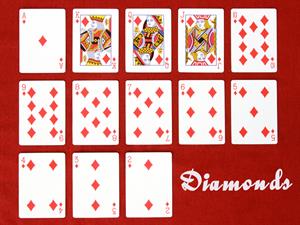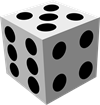
PUMPA - SMART LEARNING
எங்கள் ஆசிரியர்களுடன் 1-ஆன்-1 ஆலோசனை நேரத்தைப் பெறுங்கள். டாப்பர் ஆவதற்கு நாங்கள் பயிற்சி அளிப்போம்
Book Free DemoPlaying cards
A deck of playing cards will have 52 cards altogether.
We can sort the 52 cards into the four suits, namely, hearts, clubs, diamonds and spades.

Each suit will comprise of 13 cards.
13 cards in Spades + 13 cards in Clubs + 13 cards in Hearts + 13 cards in Diamond = 52 cards
Let us look at a set of diamond cards.

Imagine all 13 cards faced down and shuffled together. What do you think the probability would be that we pick 5 of diamonds on the first attempt?
There are 13 cards altogether and there is only one card to be picked.
So, the probability of 5 of diamonds being picked at random = \frac{1}{13}
Die
Die is a common plaything. It has 6 faces, and there are numbers from 1 to 6 engraved on each of the faces.

What do you think the possible outcomes be if a die is rolled once?
The possible outcomes include \{1, 2, 3, 4, 5, 6\}.
What is the probability that the die lands on 6 on the first attempt?
There are 6 possible outcomes, and there is only 1 favourable outcome.
Therefore, the probability of getting a 6 on the first attempt = \frac{1}{6}